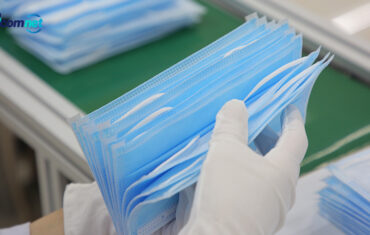Even basic cloth masks can reduce the amount of virus particles someone infected with the coronavirus emits, cutting the risk it will spread. Face covers are a key way everyone can help contain the pandemic.
2 year olds can do this
More than 30 states are requiring that anyone age 10 and older wear face masks in public. While these requirements generally apply to older kids, toddlers can safely wear face covers once they turn 2. For younger toddlers and babies there’s a risk of suffocation. The main exceptions are when they eat and possibly during exercise – times when social distancing must be enforced.
Many hours a day with face covers
Children need to wear face masks while boarding and riding the school bus, while entering and exiting school buildings and in classrooms. That adds up to as many as eight hours a day. One size can’t fit them all. The typical pediatric-sized mask is 5-10 inches wide, which may be too big or too small depending on the size of a child’s face.
Face masks should cover the nose and mouth and fit snugly under their chin. Kids can wear the same face cover all day unless it gets wet or soiled. Because masks need laundering after being worn all day, students shouldn’t use the same one to school two days in a row. Still, student masks are important for the protection of everyone around them, including the teachers, custodians, bus drivers and school staff who face the constant risk of viral exposure with in-person instruction.
Tell and show
Parents and other guardians need to talk with their children about why they need to wear a face cover. Kids 5 and under should hear that if they wear a mask. It will help keep others from getting their germs. They should know that if everyone does this, fewer people will get sick and the pandemic will end sooner. Because school-aged children tend to focus on rules, it’s best to emphasize that this is a new rule they must follow.
Teens may be hesitant to wear face masks for fear that it makes them look different. It will help to appeal to their social side. Teens who feel like everyone else is wearing masks will be more likely to don one too.
Children need learn to wash or sanitize their hands before and after putting their face covers on and the importance of leaving their masks alone once they’re in place. Before schools open their doors again, families need to practice keeping masks over little noses, keeping hands off little faces and taking masks off correctly. Don’t leave this up to teachers, who aren’t supposed to get within arm’s reach of students because of social distancing.
Toddlers want to do everything themselves, so showing them how to correctly put on their face covers. Then letting them do it themselves can make them more eager to cooperate. Preschool children are great imitators. They’re likely to follow examples set by parents or older siblings.
All parents and other guardians recognize the influence they have over their kids. If moms, dads and other loved ones wear masks whenever they come into contact with anyone outside their households, it will help ensure that the kids they care for willingly follow school rules regarding face masks.






